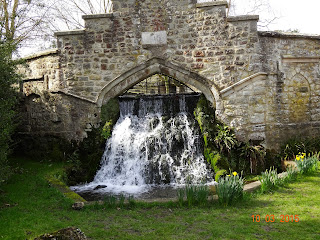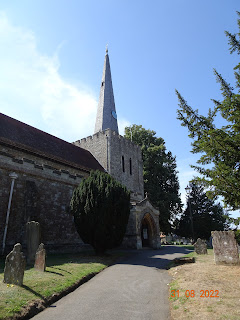West Malling used to be called Town Malling, and the approach road from the A20 is still called Town Hill.
West Malling contains several historic buildings, including St Leonard's Tower, a Norman keep built by Bishop Gundulf c.1080. He also built the White Tower of the Tower of London, the castles of Rochester and Colchester, and the Priory and Cathedral of Rochester. In c.1090 Gundulf founded St. Mary's Abbey in West Malling for Benedictine nuns. This historic site contains significant buildings from the Norman, medieval, Tudor and Georgian eras. There is also a Grade II* Listed 1966 abbey church which is used by the Anglican Benedictine nuns who have made Malling Abbey their home since 1916.
Other buildings of interest in West Malling include the Prior's House, once a residence for those with leprosy; Ford House, over 600 years old; a mainly Georgian High Street; the Swan Hotel, an 18th-century coaching inn (Grade II listed), and Went House, built c.1720 and noted for its elegant brickwork. Manor Park Country Park is just to the south of the town, close to St Leonard's Tower and Douce's Manor, whose grounds the park once comprised.
Whereas it used to be on the main road from the M20 towards Tonbridge, West Malling has now been by-passed, which makes it a very pleasant place to visit indeed. There's plenty of nice shops and places to eat.
The Abbey - the main part of which lies in ruins - has a charming waterfall, known as The Cascade, which lies outside the Abbey walls, and which is thus easy to view. It was once painted by JMW Turner.
Turner was estimated by art historians, to have painted this when he was only 15 or 16 years old.
It really hasn't changed much since Turner painted it!
After more than 900 years of occupation, the 12 remaining Benedictine nuns are threatening to leave the abbey if plans for 65 houses to be built opposite the abbey, as they feel it would intrude on their tranquility.
.
As explained on the board, Band 2 depicts a flight of Mosquito aircraft from West Malling airfield during World War II. Before he went on to lead the 'Dambusters' raids, Guy Gibson was Wing Commander at West Malling, and he reckoned it was the prettiest airfield anywhere in the UK
A fire insurance plaque on one of the medieval buildings, shows that the owners had purchased insurance, and in the event of fire, were entitled to assistance from the insurance company's own fire brigade.
That was a pretty heavy game of chess, by the looks of this plaque :)
Above, a Georgian portico somewhat resembling Lego bricks! I found a very similar one in Faversham
The old town brewery above, is now very smart apartments. It's nice seeing these old industrial buildings being preserved, even if they no longer represent the reason they were first built.
Ah...the sound of leather on willow......................the first recorded cricket match in Kent. It led to the first County cricket ground being established there.
The above two plaques are to be found at the entrance to St. Mary's Benedictine Abbey. Gundulf was Bishop of Rochester, whose see included West Malling.
At the bottom of the town stands the parish church of St. Mary The Virgin. The quite plain, but the quite imposing war memorial stands in front of it at the side of the road
I was surprised at how plain the church is inside. The only really remarkable thing is the tomb of Sir Robert Brett, his wife and only son, who predeceased them. Sir Robert died in 1620. The recent restoration goes to show how splendidly colourful churches must have been.
Henry, their only child is depicted kneeling by the heads of his parents. The statue of Death at the feet of the effigies, shows that the line died with them
The organ is by Henry Jones (1879), overhauled and enlarged by Colin Jilks in 1999. It comprises 17 stops on 2 manuals and pedal. The facade pipes are stencil-painted and gilded in the high Victorian style.
With his guidance, HMS Minotaur successfully protected the rear of HMS Victory at the Battle of Trafalgar. There is a transcript of Capt. Mansfield's log for HMS Minotaur at Trafalgar here:
They also fought at the Battle of the Nile, and that of Copenhagen






































No comments:
Post a Comment